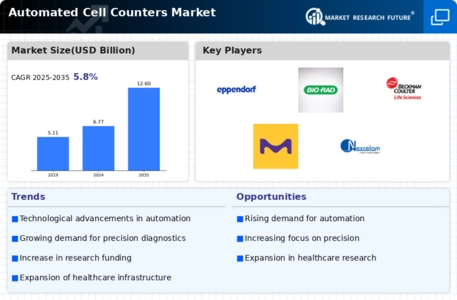Leading market players are investing heavily in research and development in order to expand their product lines, which will help the automated cell counters market, grow even more. Market participants are also undertaking a variety of strategic activities to expand their footprint, with important market developments including new product launches, contractual agreements, mergers and acquisitions, higher investments, and collaboration with other organizations.
To expand and survive in a more competitive and rising market climate, automated cell counters industry must offer cost-effective items.
Manufacturing locally to minimize operational costs is one of the key business tactics used by manufacturers in the automated cell counters industry to benefit clients and increase the market sector. In recent years, the automated cell counters industry has offered some of the most significant advantages to medicine.
Major players in the Automated cell counters market, including Eppendorf, Thermo Fischer Scientific, Countstar Inc., Bio-Rad Laboratories Inc., F. Hoffmann-La Roche Ltd, Chemometec A/S, ALIGNEDGENETICS, Beckman Coulter, Inc. (Danaher), Nanoentek, Olympus Corporation, MERCK KGaA, Sysmex Corporation, Agilent Technologies, Inc., Abbott, Nexcelom Bioscience LLC and others, are attempting to increase market demand by investing in research and development operations.
Thermo Fisher Scientific Inc. (Thermo Fisher) delivers medical equipment, analytical instruments, reagents and consumables, software, and services to satisfy the demands of challenging analytical challenges in research, diagnostics, and clinical laboratories. It offers solutions for cellular biology, synthetic biology, and flow cytometry. Mass spectrometry, genetic sequencing, electron microscopy, protein, and molecular biology research equipment are just a few of the many products that the company sells.
The company offers services to companies in the environmental, industrial quality, and process control sectors, as well as to academic and research institutes, governmental organizations, pharmaceutical and biotech companies, clinical diagnostic laboratories, and environmental companies. It provides its products and services through its direct sales force, online sales, and third-party distributors across the Americas, Asia-Pacific, and Europe. The headquarters of Thermo Fisher are located in Waltham, Massachusetts, in the US.
Abbott Laboratories (Abbott) discovers, develops, manufactures, and sells a wide range of healthcare products, including branded generic drugs, diagnostic devices, and infant, child, and adult nutritional supplements. Additionally, the company sells a variety of medical devices, including those for heart failure, neuromodulation, electrophysiology, rhythm management, and vascular and structural cardiac devices.
Additionally, the company offers nutritional products, minerals, and dietary supplements. It has production facilities all around the world and R&D facilities in the US, China, Colombia, India, Singapore, Spain, and the UK. Africa, the Middle East, Latin America, North America, and the Asia-Pacific area are among the regions where the firm sells its products. Abbott is based in Abbott Park, Illinois, a city in the US.
















